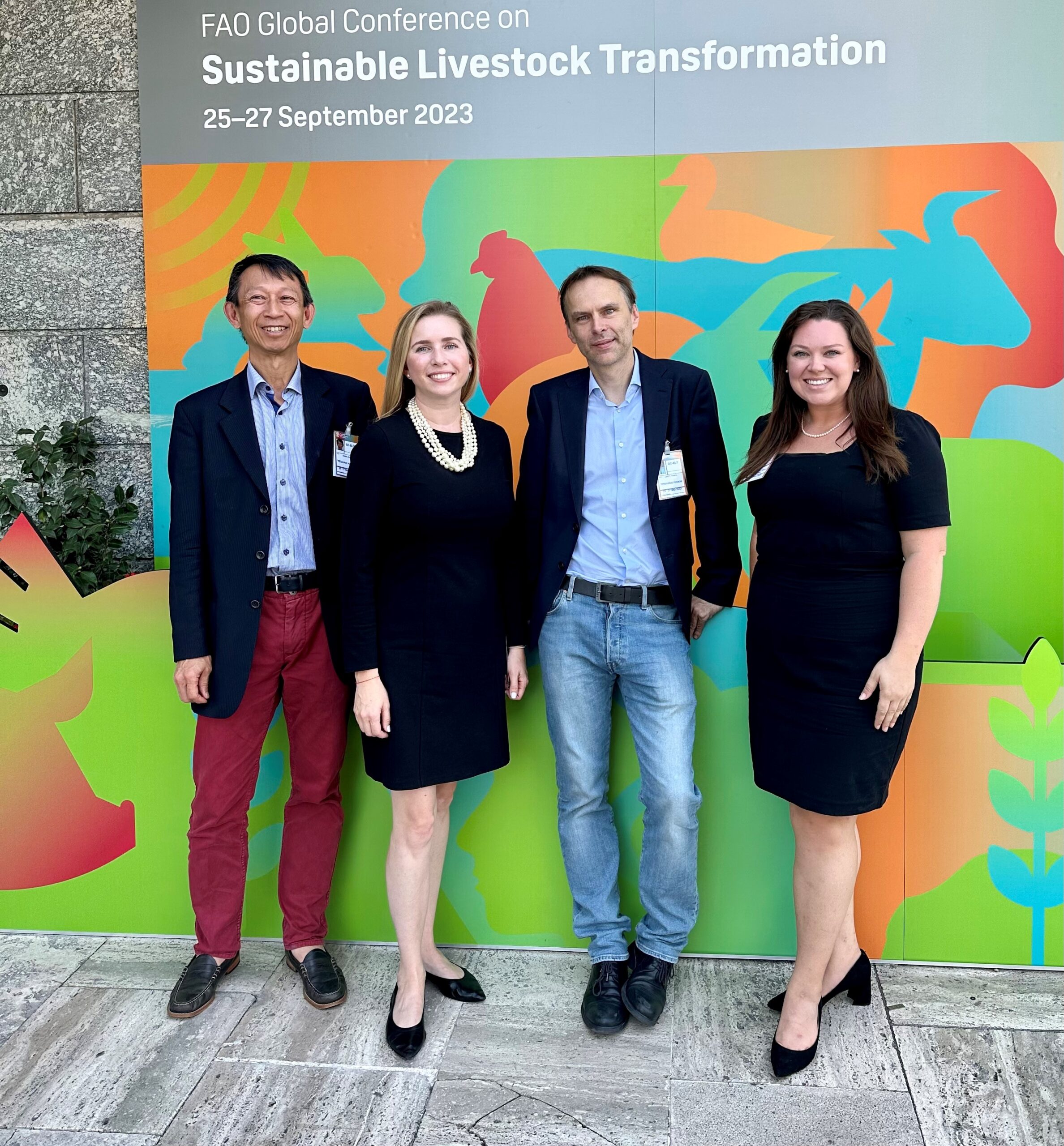For the Week Ending September 29, 2023
In this week’s National Pork Producers Council (NPPC) Friday recap: pork producers brace for a federal government shutdown as NPPC pens LMR letter to Secretary Vilsack; NPPC weighs in on USDA proposal to update reportable diseases; NPPC’s Zieba attends FAO conference on sustainable livestock production; NPPC supports legislation to increase USDA farm operating and ownership loans; and USDA unveils grant program aimed at facilitating H-2A usage. Take a deeper dive below.
Producers Should Prepare for Government Shutdown; NPPC Pens LMR Letter to USDA
What happened: At the time of publication, the federal government was facing the prospect of closing because Congress (so far) failed to approve funding for fiscal year 2024, which begins Oct. 1.
In preparation, NPPC joined the American Farm Bureau Federation, the American Sheep Industry Association, the National Cattlemen’s Beef Association, and the North American Meat Institute in urging the U.S. Department of Agriculture (USDA) to continue publishing livestock price reports should the government shut down. The Livestock Mandatory Reporting (LMR) Act, which expires Sept. 30 if Congress doesn’t reauthorize the statute, requires meatpackers to report to USDA the prices they pay for cattle, hogs, and lambs. USDA then publishes reports with information on pricing, contracting for purchase, supply and demand conditions for livestock, livestock production, and livestock products.
In the Sept. 22 letter to Agriculture Secretary Tom Vilsack, the livestock groups asked him to deem USDA personnel who publish the twice-daily price reports “essential,” meaning they would not be furloughed if the funding for federal agencies lapses with the end of the fiscal year — Sept. 30.
Why it’s important: Without funding, many federal programs will cease, and the staff who administer them will be furloughed. Among the programs that could be idled is the LMR Market News.
LMR helps ensure livestock producers have reliable and accurate information when making critical business decisions and supports competition and transparency in the livestock industry. Failure to continue publishing reports would jeopardize swine, cattle, and lamb producers’ ability to market their animals effectively.
NPPC’s take: NPPC and the other livestock organizations support designating USDA’s LMR staff as essential personnel during a government shutdown, an action previously taken during the 2018-2019 shutdown.
NPPC Comments on Proposal to Update Reportable Diseases
What happened: NPPC submitted comments to the USDA’s Animal and Plant Health Inspection Service (APHIS) on the agency’s proposal to amend animal disease regulations associated with the National List of Reportable Animal Diseases (NLRAD). Accredited veterinarians are legally required to report suspicion or diagnosis of select diseases to federal and state animal health officials. For swine, such “notifiable” diseases include African swine fever, Nipah virus, and classical swine fever. “Monitored” diseases include porcine reproductive and respiratory syndrome (PRRS) and transmissible gastroenteritis, which can currently be reported voluntarily.
Why it’s important: APHIS is proposing to update the NLRAD list to include additional diseases that the World Organization for Animal Health tracks make reporting of “these monitored” diseases mandatory for states (not by producers), and expand the reporting requirement to include animal health officials other than veterinarians.
NPPC’s take: In its comments, NPPC indicated support for:
- Limiting reporting requirements to veterinary diagnostic laboratories and accredited veterinarians.
- Developing a voluntary portal for receiving reports on “suspicious” animal health events.
- Establishing specific case definitions for each reportable disease, as well as a summary of succeeding events associated with a report of individual diseases.
- Mandatory reporting of “monitored” diseases by states only if they have the needed resources to facilitate such reporting.
FAO Conference Promotes Sustainable Livestock Production
What happened: NPPC Vice President of International Affairs Maria C. Zieba attended the first-ever Global Conference on Sustainable Livestock Transformation, hosted by the U.N.’s Food and Agriculture Organization (FAO) in Rome. The event brought together producer organizations, research and academic institutions, development agencies, civil society organizations, and private-sector entities to discuss ways to efficiently produce more nutritious, safe, and accessible animal foods while reducing livestock’s environmental footprint and contributing to diversified livestock systems that are more resilient to shocks and disruptions. NPPC’s presence served as a reminder of the U.S. pork industry’s successes in sustainability.
The goals of the FAO conference were to raise awareness of the contributions of sustainable livestock production, share information and knowledge on the strategic direction and technical developments in sustainable production worldwide, and establish priorities for the mobilization and pooling of scientific, technical, and financial resources to achieve global sustainable livestock transformation.
Why it’s important: FAO member countries work to defeat hunger and enhance food security, ensuring people around the globe have regular access to high-quality food. For livestock agriculture, the organization promotes better production systems, nutrition, environmental stewardship, and quality of life. As the FAO works towards establishing priorities in the livestock sustainability it is important for U.S. pork producers to have a voice in shaping FAO policies and goals of fostering more efficient and resilient production.
NPPC’s take: NPPC supports the FAO’s efforts to offer the U.S. pork industry as a model of sustainability, pointing out that over the past 60 years, pork producers have reduced their use of land by 76%, water by 25%, and energy by 7%. That has decreased producers’ carbon footprint by 8%, while annual pork production has increased from 12 billion to 24 billion pounds.

Left to right: International Meat Secretariat Secretary General Hsin Huang, NPPC Vice President of International Affairs Maria C. Zieba, Vrije University Brussels Food Science and Biotechnology Professor Frederic Leroy, and NCBA Government Affairs Chief Counsel Mary-Thomas Hart.
FAO Global Conference on Sustainable Livestock Transformation in Rome, Italy.

Legislation Would Increase USDA Farm Operating, Ownership Loans
What happened: Reps. Brad Finstad (R-MN) and Angie Craig (D-MN), who both are members of the House Committee on Agriculture, have introduced the “Producer and Agricultural Credit Enhancement (PACE) Act” to update current limits on the U.S. Department of Agriculture’s Farm Service Agency (FSA) farm ownership and operating loans, which were established in the 2018 Farm Bill.
The legislation (H.R. 5631) would increase FSA Guaranteed Operating Loans to $3 million from $2.04 million, Guaranteed Ownership Loans to $3.5 million from $2.04 million, Direct Operating Loans to $750,000 from $400,000, and Direct Ownership Loans to $850,000 from $600,000.
Why it’s important: FSA operating and ownership loans help ensure farmers have access to the financing needed to start, expand, or restructure their family operations. Operating loans can be used to purchase livestock, seed, crop protection tools, and farm equipment, among other operating costs. Ownership loans can be used to purchase farmland and assist with loan closing costs, construct or improve buildings on the farm, or assist with soil and water conservation practices.
NPPC’s take: NPPC supports the Finstad-Craig bill’s expansion of the FSA farm loan amounts as a way to give farmers access to more capital to run their operations.
New USDA Grant Program Aimed at Facilitating H-2A Usage
What happened: The USDA recently announced a pilot program — the Farm Labor Stabilization and Protection (FLSP) Program — to help address U.S. agriculture’s workforce needs, with grants totaling up to $65 million to facilitate H-2A visa program usage. Administered by the USDA’s Agricultural Marketing Service and the Farm Production and Conservation Business Center, FLSP is intended to provide support for agricultural employers using the H-2A program and increase labor standards and protections.
Why it’s important: U.S. agriculture, which relies heavily on immigrant workers, has a severe labor shortage. Shrinking rural populations, declining immigration to rural areas, and a rising median age of farmers have contributed to the lack of available workers and caused negative effects throughout the food supply chain, including in the U.S. pork industry. H-2A visas allow agricultural employers to bring a limited number of foreign nationals to the United States to fill temporary seasonal farm jobs.
Eligibility: To be eligible for an FLSP grant, U.S. agricultural employers must meet all Department of Labor and Department of Homeland Security H-2A regulatory requirements, including showing insufficient availability of U.S.-based workers. Employers must also commit to complying with the increased worker protection requirements of the FLSP Program, especially those related to worker benefits and compensation. The minimum award amount is $25,000, and the maximum is $2 million, per grant agreement. Applications for the FLSP Program must be received by Nov. 28. Click here for more information on the program and about the application process.
NPPC’s take: NPPC supports expanding access to the H-2A visa program. However, NPPC believes the FLSP Program adds several burdensome requirements related to worker benefits for grant awardees, especially those seeking larger grants. It also does not provide access for year-round labor, which would ultimately require legislative action. Larger employers may be able to meet the added requirements, though smaller employers may struggle. The application process is complicated, and many would benefit from having a lawyer to help navigate it; however, USDA will provide technical assistance. The cost of meeting the program criteria could also be greater than some of the smaller grant amounts. Although the FLSP Program may ease some of agriculture’s labor issues, it does not address livestock industry shortages, which needs H-2A access for year-round workers without numerical caps.